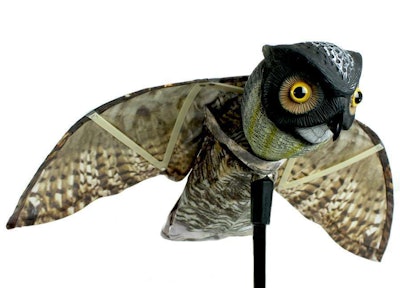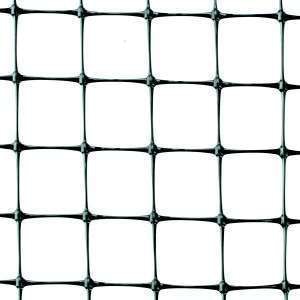 Visual scares such as this replica of a prowler owl, the most feared of aerial predators, can keep birds and small pests away.
Visual scares such as this replica of a prowler owl, the most feared of aerial predators, can keep birds and small pests away.EDITOR’S NOTE: This column was provided by Bird-X, a Chicago-based company specializing in humane pest and bird-control products.
A perfect landscape boasts both beauty and safety. When you create landscape designs for your clients, the last thing you want is to have them destroyed by unwanted pests.
Creating a comforting and pest-free environment doesn’t need to be complicated. Consider these solutions.
Alternative landscape design options
Enjoying the outdoors on a warm summer evening is blissful … until those pesky mosquitoes show up and everyone runs for shelter. Consider using these plants and herbs that naturally repel mosquitoes:
- Pennyroyal: This groundcover does double duty by deterring mosquitoes and attracting beautiful butterflies.
- Marigolds: This hardy annual makes a beautiful bright addition to any flowerbed, or space them out as a border around your vegetable garden to help keep away pesky bugs.
- Geraniums: These flowers give your area an extra POP while serving as another mosquito repellant. They grow perfectly in hanging baskets, so you can test them in multiple areas until you find the right fit.
- Fragrant herbs: Planting herbs like garlic, basil, lemongrass, or mint near the front and back doors can prevent bugs from making their way inside. Citronella, a lemon-scented grass, is another effective bug repellant when crushed to release oils.
Broad-spectrum chemical insecticides kill the good insects (for example, honeybees, soldier bugs, lady beetles) with the bad (cabbageworms and potato beetles). Try these preventive and proactive alternatives to chemical insecticides:
- Clean up! Destroy infested plants your clients may have and remove leaves, fallen fruit and anything else pests may be attracted to.
- Install insect traps that attract pests with scents.
- Invite the good bugs by using about 5 to 10 percent of the planting space to plant annuals, perennials, trees and shrubs that attract beneficial insects. When possible, plant strategically for year-round blooms so the good bugs stay all year long.
They may be cute to look at, but deer and rabbits are unwelcomed guests in a vegetable or flower garden. Try these tips to keep them and other wildlife away:
- Install low fences to block small animals like rabbits, moles, and dogs, and install larger ones to fend off deer. Also installing fencing several inches underground may prevent some critters from burrowing underneath.
- Use row covers, which not only protect plants from frost and bad weather, but also impede a variety of pests from destroying them, from caterpillars and insects to birds and squirrels.
- Protect delicate plants like berries or fruit trees from birds and bats with netting as a barrier option. Make sure the netting is small enough, since smaller critters, including mice, can work their way through larger holes.
- Plant flowers and plants deer dislike, such as daisies, tiger lilies, wisteria, irises, geraniums, dahlias, wormwood and boxwood. Deer also hate some of the same herbs that repel bugs.
- Consider flowers that are rabbit-resistant. Rabbits aren’t shy when it comes to making a smorgasbord out of a garden—they’re known to eat just about anything if they’re hungry enough. However, these flowers are usually not appealing to them: veronica, salvia, peonies, Siberian irises, daylilies, allium (also disliked by deer and squirrels), lavender, daffodils, foxglove plants, and more.
Of course, you’ll need to take into account the climate, soil and other conditions in your area when choosing what to plant. You may want to research wildlife that is problematic in your part of the country.
How design can attract pests
 Bird-X says its half-inch polypropylene netting is a strong and durable barrier to both birds and pests.
Bird-X says its half-inch polypropylene netting is a strong and durable barrier to both birds and pests.Certain types of mulch attract unwanted pests. Avoid using mulch against homes or buildings. If the client requests it, be sureto explain potential consequences of its use and instead recommend safer mulch, such as cedar bark, that actually helps keep pests away.
Certain plants, such as azaleas, tulips, pansies, hybrid roses, impatiens, garden phlox and daylilies attract deer. Deer love their veggies, too, especially beans, potatoes, corn, peas and alfalfa. Fruit trees also draw deer and other unwanted animals onto your property, so it’s crucial to know the area before you design a new landscape layout.
Remember, too, that birdbaths and other containers that hold standing water are magnets for mosquitoes.
Humane pest solutions
Advise your clients to steer clear of chemicals and inhumane pest control and take advantage of the wide variety of humane pest solutions. Here’s a sample of the types of products that are 100-percent safe, humane and maintenance-free:
- Electronic animal and insect repellents. Using sonic or ultrasonic frequencies and solar-powered flashing lights, these devices work on pests big and small. They target animals like deer, raccoons, moles, stray cats, as well as tiny destroyers like ticks, ants, fleas and other insects.
- Electronic bird control devices. These devices frighten birds and condition them not to return to an area.
- Bird spikes and netting. An effective option for preventing birds from landing on specific areas like on chimneys or where crops must be kept safe.
- Visual scares. Predator replicas and other scare products intimidate unwelcomed birds, geese and other small animals – and they’re a great option for your clients on a budget.
- Organic animal repellants. These granules are unappealing to mice, rats and other pests. Sprinkle them around flower and vegetable gardens to keep pests at bay.
Keeping these concepts in mind when designing your professional landscapes will create budding relationships between you and your clients, as well as your clients and their new environments.
This article was written by Ellen Borza, a content developer for Bird-X.









